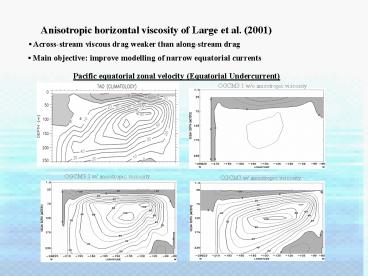Acrossstream viscous drag weaker than alongstream drag - PowerPoint PPT Presentation
1 / 28
Title:
Acrossstream viscous drag weaker than alongstream drag
Description:
Across-stream viscous drag weaker than along-stream drag ... vert diff: kV=0.3. vert visc: AV=20. 1950-79. 1950-98. 3. kV=0.1 AV=5. Effect of vertical mixing ... – PowerPoint PPT presentation
Number of Views:49
Avg rating:3.0/5.0
Title: Acrossstream viscous drag weaker than alongstream drag
1
Anisotropic horizontal viscosity of Large
et al. (2001)
Across-stream viscous drag weaker than
along-stream drag
Main objective improve modelling of narrow
equatorial currents
Pacific equatorial zonal velocity (Equatorial
Undercurrent)
OGCM3.1 w/o anisotropic viscosity
OGCM3.1 w/ anisotropic viscosity
CGCM3 w/ anisotropic viscosity
2
Barotropic Streamfunction in CGCM3/T47
Standard lateral viscosity
Large et al. (2001) Isotropic viscosity
3
Tropical Pacific SST variability CGCM1/2/3
obs
1950-98
1950-79
Central Pacific variability
3
2
1
CGCM1/2/3 control (flux adjusted)
W Pacific variability
4
Effect of flux adjustment
obs
1950-98
1950-79
Central Pacific variability
3
2
1
3
CGCM3 control (non-flux adjusted)
W Pacific variability
5
Effect of vertical resolution
obs
1950-98
1950-79
Central Pacific variability
3
2
1
CGCM3 control (non-flux adjusted)
3
3
- ? 15 m upper layer
W Pacific variability
6
Effect of vertical mixing
obs
1950-98
1950-79
Central Pacific variability
2
1
AV5
3
3
3
Model defaults vert diff kV0.3 vert visc
AV20
3
kV0.1
W Pacific variability
7
Effect of vertical mixing
obs
1950-98
1950-79
Central Pacific variability
kV0.1 AV5
3
2
1
AV5
3
3
3
Model defaults vert diff kV0.3 vert visc
AV20
3
kpp
kV0.1
W Pacific variability
8
Effect of KPP mixed layer
obs
1950-98
1950-79
Central Pacific variability
3
2
1
CGCM3 control (non-flux adjusted)
3
L33
3
3
kpp
W Pacific variability
9
Effect of anisotropic viscosity
obs
1950-98
1950-79
Central Pacific variability
3
aniso
2
1
CGCM3 control (non-flux adjusted)
3
3
L29
W Pacific variability
10
Standard deviation of SST
(GT)
CGCM3/T47 (flux adj)
HadISST
w/ aniso visc (no flux adj)
CGCM3/T47 (no flux adj)
11
- Burgers and van Oldenborgh (J Clim 2003)
Correlation between observed and modeled SST
Thermocline feedback
Wind stress zonal advection feedback
Both
12
- Canadian Clivar Research Network Project on
Tropical - Atmosphere/Ocean Model Dynamics
- G. Boer, G. Flato, W. Merryfied, B.
Pal - Objectives what are sources of errors in coupled
model tropical variability? - Use decoupling approach
AGCM
AGCM or OBS
OGCM
OBS SST
13
CGCM2 Control Years 1900-2850
Extra Slides
CGCM2
NCEP 1948-2001
14
Standard deviation of SST
(GT)
CGCM3/T47 (flux adj)
HadISST
w/ aniso visc (no flux adj)
CGCM3/T47 (no flux adj)
15
regressions of SST with NINO3/4
obs NINO3
CGCM1 NINO4
CGCM2 NINO4
CGCM3 NINO4
oC/ oC
oC/ oC
estimated from ground temperature
16
NINO3 power spectra
Obs vs CGCM1
Obs vs CGCM2
Obs vs CGCM3
Observations 1903-1991
Kaplan SST
estimated from ground temperature
17
Time series annualmean NINO3 anomalies
Obs
CGCM1
CGCM2
CGCM3
18
Model NINO3/4 amplitudes
CMIPENSIPSTOIC N24 global coupled models
19
Is it ocean resolution?
20
Is it ocean resolution?
HadCM3
HadCM2
21
Is it ocean resolution?
22
Is it the mean ocean?
clim PHC2.0
CGCM1
CGCM2
CGCM3
23
Is it the mean ocean?
Effects of flux adjustment
clim PHC2.0
CGCM3 flux adj
CGCM3 non-flux adj
Note too-cold cold tongue, too warm coastal E Pac
24
CCSM2 mean SST
NINO3 spectrum
obs
CCSM2
CSM1
6
3
2
1.5
1
Period (years)
25
Is it the mean winds?
NCEP
CGCM1
CGCM2
CGCM3
26
Is it the mean winds?
NCEP
CGCM1
STOIC 15 models
CGCM2
CGCM3
27
Is it the wind response to SST anomalies?
- Kirtman J Clim 1997 ENSO period sensitive to
meridional breadth of wind stress anomaly
28
Is it the wind response to SST anomalies?
Regressions of zonal wind stress with NINO3
NCEP
CGCM2





![⚡Read✔[PDF] Kings of Drag 3: High quality studio photographs of British Drag Kings PowerPoint PPT Presentation](https://s3.amazonaws.com/images.powershow.com/10077751.th0.jpg?_=202407120111)

![⚡[PDF]✔ It's a Drag: Cross-Dressing in Performance PowerPoint PPT Presentation](https://s3.amazonaws.com/images.powershow.com/10053405.th0.jpg?_=202406111110)
![[PDF]❤️DOWNLOAD⚡️ It's a Drag: Cross-Dressing in Performance PowerPoint PPT Presentation](https://s3.amazonaws.com/images.powershow.com/10045817.th0.jpg?_=202406031212)


![[PDF]❤️DOWNLOAD⚡️ It's a Drag: Cross-Dressing in Performance PowerPoint PPT Presentation](https://s3.amazonaws.com/images.powershow.com/10046829.th0.jpg?_=20240604125)



















